Hosoya Enterprises Plays with Fireworks
Memories of days past...A chance for reflection...
Some of the Captain's fondest memories as a youth were his times spent launching bottle rockets from his college dorm window at the coeds heading off to their morning classes on the sidewalks below. (Didn't know the Captain attended an institution of higher learning, did you?)
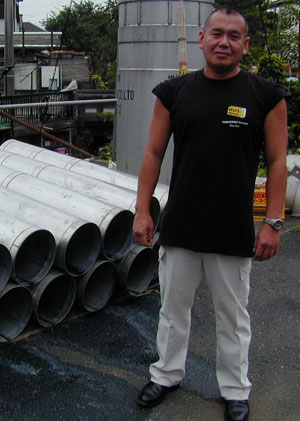 For regular readers of this column, it is indeed not surprising to find that the Captain likes to play with fire. And this week he explores the making of fireworks in Japan by profiling one of the industry's most respected companies. Stand back and enjoy all the pretty colors.
For regular readers of this column, it is indeed not surprising to find that the Captain likes to play with fire. And this week he explores the making of fireworks in Japan by profiling one of the industry's most respected companies. Stand back and enjoy all the pretty colors.
At the edge of a parking lot of a secluded office block in Akiruno City, Saitama Prefecture rests a dozen stainless steel tubes. A dark liquid trickles out from their open tops and an unmistakable whiff of sulfur hangs in the air - both lingering remnants of their use the night before.
"This is the crazy Japanese style," laughs Joji Hosoya, the stocky and deep-voiced vice-president of Hosoya Enterprises, one of Japan's premier fireworks companies.
That is indeed an apt description. With the open tops pointed skyward, the tubes are used to launch bundled pods filled with a variety of chemicals and explosive compounds. The hanabishi (fireworks setter) drops each sphere inside, where an explosion of gunpowder provides the element for launch, and ducks out of the way as the burning piece hurtles skyward for an explosion of lights and sonic report.
As a result, a singed work coat and hands darkened with carbon are standard in this family business, started by Joji's grandfather's grandfather nearly 100 years ago. But such byproducts of the work are no secret; there is a family saying that has been passed down through the ages which insists that one must first wash their face with fire in order to become a hanabishi.
Manufacturing fireworks is a business that has served the family well. With techniques handed down through the generations, the handcrafted fireworks of Hosoya have made it one of the most recognizable names in what has become not only tradition at thousands of festivals across Japan each year but also an art.
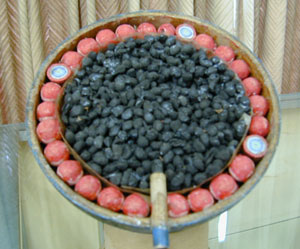 Even the most casual fireworks festival fan realizes that splashes of red, white, yellow, green, and blue are often blended to create multi-colored layers, emanating through blooms, bursts, and sparkles from one firework to another. But with all the pyrotechnic activity unfolding in the night's sky over the course of a show, most people don't realize that there are really only three basic design variations.
Even the most casual fireworks festival fan realizes that splashes of red, white, yellow, green, and blue are often blended to create multi-colored layers, emanating through blooms, bursts, and sparkles from one firework to another. But with all the pyrotechnic activity unfolding in the night's sky over the course of a show, most people don't realize that there are really only three basic design variations.
Small spheres of explosive paste (called hoshi, or stars) are the key components and responsible for the colors. For the warimono variation, which bursts into concentric circles of color before streaming earthward, makers add layer upon layer of different types of stars evenly inside two separate hemispheres. The packing must be tight around the blasting charge located at the center. The shells are joined into one sphere around a dangling fuse and then carefully wrapped in paper with the end result resembling something akin to a brown legume.
This uniform packing, a skill which necessitates the steady eye of a true craftsman, provides the symmetry seen within the exploding rings of color. Joji, though, emphasizes that it takes at least three years of training to learn to wrap the hemispheres in paper properly, another two to learn how to make the stars. "Beginners have a difficult time with this," he says while cupping his left hand and moving it like an ongoing explosion in the sky. "Getting the vibrant colors to come from the center properly is very difficult."
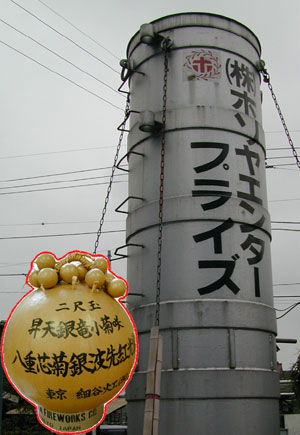 For the other two constructions, the method is similar but their contents are slightly different. Kowarimono fireworks have stars positioned in a non-uniform, hodgepodge manner to create dozens of random bursts of color, or "blooming moons," upon detonation. And wild starmines, as characterized in pokamono shells, dance and sizzle as a result of their stars being shaped like cylinders, the non-aerodynamic nature of which creates streaking colors and unpredictable directions of motion.
For the other two constructions, the method is similar but their contents are slightly different. Kowarimono fireworks have stars positioned in a non-uniform, hodgepodge manner to create dozens of random bursts of color, or "blooming moons," upon detonation. And wild starmines, as characterized in pokamono shells, dance and sizzle as a result of their stars being shaped like cylinders, the non-aerodynamic nature of which creates streaking colors and unpredictable directions of motion.
Hosoya's signature piece, the sanjakudama, is the Godzilla of all fireworks and often used in show promotions to ensure large crowds. Measuring 90 centimeters in diameter and with a weight equivalent to that of a sumo wrestler (280 kg), this firework requires six months and two million yen to produce - an outlay that many makers (of which there are only a handful qualified in Japan) will liken to the giving away of a daughter to marriage upon its firing. By contrast, more common shells will be slightly bigger than a human hand and cost between 1,600 and 3,500 yen to make.
The launch of such a beast is complicated. Hoisted with a crane and placed in a vertical trash barrel-sized mortar tube supported with extensive cross-bracing, this crowd pleaser is sent 700 meters into the air via a wired-remote electrical charge. Its lateral reach upon explosion is such that shows need to clear a safety zone of 600 meters in diameter.
Of course, the mere mention of a sanjakudama on a marquee is not enough to ensure success. The key to any show is in its timing, Joji says.
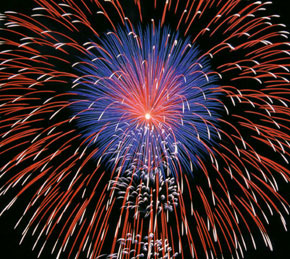 Even though they are certainly favorites, what is the point, Joji asks, of continually launching flowering chrysanthemum (kiku) after flowering chrysanthemum? Start with a slow tempo, he enthuses. This might include one kiku, followed by a single-coned peony (botan), and then some rapid bursts of starmines. Then, he says, up the pace a bit to a higher tempo. Sprinkle in bits of silence for contrast, and the next thing you know the crowd will be drooling for the grand finale, the point where sometimes a full quarter of the night's action is launched to the sky.
Even though they are certainly favorites, what is the point, Joji asks, of continually launching flowering chrysanthemum (kiku) after flowering chrysanthemum? Start with a slow tempo, he enthuses. This might include one kiku, followed by a single-coned peony (botan), and then some rapid bursts of starmines. Then, he says, up the pace a bit to a higher tempo. Sprinkle in bits of silence for contrast, and the next thing you know the crowd will be drooling for the grand finale, the point where sometimes a full quarter of the night's action is launched to the sky.
Various subtle effects can be added. Special parachutes provide delayed falls to earth giving the appearance of "floating flare moons," while whistles and flashes also can add to a show's overall creativity. "Mixing and matching - a combination of small and big is important," Joji explains in a booming voice that matches his explosive profession.
Show budgets, though, have been cut in recent years due to Japan's dire economic condition. In a sign of the times, last year Hosoya launched only two sanjakudama, and this year not one has left the company's factory in Shizuoka Prefecture.
With their transient nature inspiring haiku poets over the centuries, fireworks have permeated society to such an extent as to be directly associated with Japanese culture.
The heaviest season is summer, and no event is bigger than the Sumida River Fireworks Festival in July. Packed onto the river's banks, more than 300,000 revelers deck themselves out in traditional yukata and slurp plates of yakisoba with cold beer as tens of thousands of shells snap and crackle into bands of light high above the river's surface.
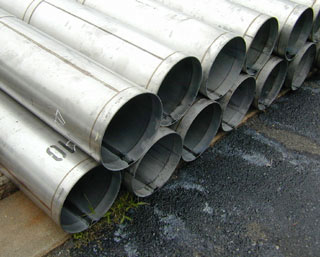 The show's history runs deep. The festival traces its roots to the Edo Period (1600-1868), where it was originally used as a means of mourning the souls of famine and plague victims. During the Meiji period (1868-1912), the festival became so popular that, as legend has it, festival goers could hop from one yakatabune (roofed-boat) to the next all the way across the river.
The show's history runs deep. The festival traces its roots to the Edo Period (1600-1868), where it was originally used as a means of mourning the souls of famine and plague victims. During the Meiji period (1868-1912), the festival became so popular that, as legend has it, festival goers could hop from one yakatabune (roofed-boat) to the next all the way across the river.
Though the idea was similar in those days, the fireworks on show were much different from that of today. Materials were limited. As a result, citizens of the time saw the night sky turn to shades of orange as the equivalent of barbecue charcoal briquettes were launched from wood tubes wrapped in bamboo.
Recent years have seen the technology make a full circle with regards to its roots. Since arriving in Japan from China about 400 years ago, fireworks detonated here are increasingly being manufactured in China due to its cheap labor.
Joji scoffs at the lack of charm in the computer-controlled, push-button approach to launching fireworks, as favored in most other countries for safety reasons. Still, Japanese extravaganzas (even those conducted by Hosoya) have been using such means - especially for quick-firing starmines. Mortar tubes are bundled into box shapes with electric wires attached to each tube. A control panel is then used to remotely set off each launch at the appropriate time.
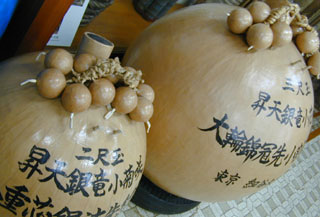 Hosoya has a history of innovation that goes beyond standard fireworks. Joji's grandfather allegedly brought the explosive party favorite "Christmas crackers" to Japan. He also was responsible for introducing the exploding golf ball to golf tournament opening ceremonies. More recently, music group Southern All Stars have employed Hosoya to create pyrotechnic stage effects in time with their thumping rock rhythms.
Hosoya has a history of innovation that goes beyond standard fireworks. Joji's grandfather allegedly brought the explosive party favorite "Christmas crackers" to Japan. He also was responsible for introducing the exploding golf ball to golf tournament opening ceremonies. More recently, music group Southern All Stars have employed Hosoya to create pyrotechnic stage effects in time with their thumping rock rhythms.
But Joji hasn't abandoned the basics; he still gets his hands dirty as a hanabishi. He can be found dropping and ducking next to mortar tubes at some of Hosoya's smaller events. For bigger shows, he plays the "conductor," presiding over 40 to 50 hanabishi at a time.
Even though modern trends have shaped the industry - with pyrotechnic images of cartoon characters (Pokemon and Hello Kitty, for example) and other bits of pop culture being increasingly in demand - Joji's emphasis remains on quality fireworks making, not fleeting fashion.
"All I want is for people to feel excited," he says.
Note: Fumiko Kojima contributed to this report from the Saitama Bureau.

